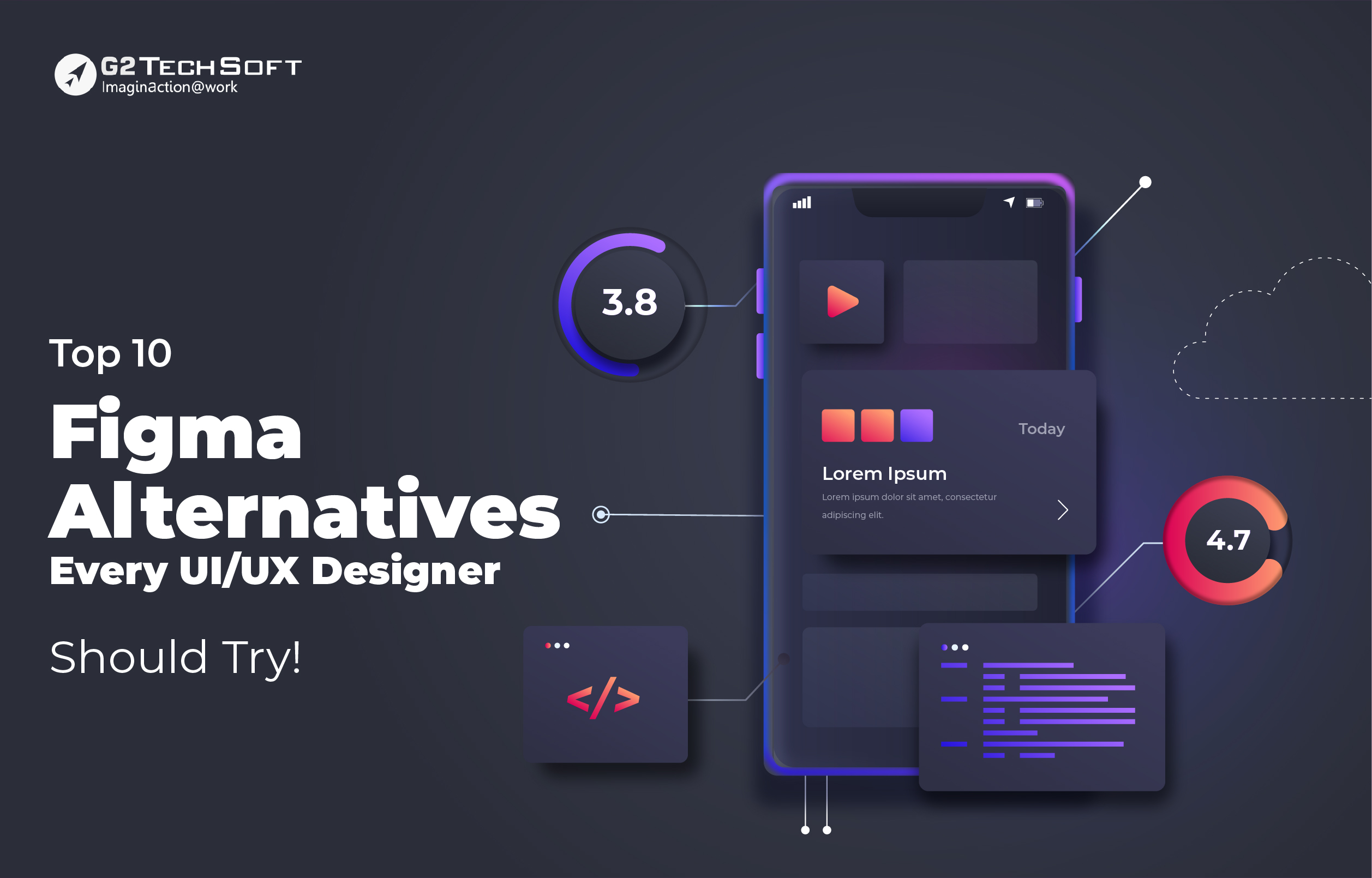
Top 10 Figma Alternatives Every UI/UX Designer Should Try!
Figma has established itself as one of the top web design software and easiest web design software options for creating website designs and web applications in recent years. As a digital design platform known for its real-time collaboration features and user-friendly interface, Figma has become a staple tool among UI and UX designers. However, its recent acquisition by Adobe in 2022 has raised questions among some users.
As the website development software and website design software are owned by a large corporation, there are concerns that Figma may change in ways that no longer meet designers’ needs. As a result, many in the web design community have started exploring popular Figma alternatives. By comparing the different web design tools available, like Figma, and the best web designer software options, users can ensure they have the right digital design program that supports their workflow now and in the future.
In this blog post, let’s find out the top 10 Figma alternatives every UI/UX designer should try.
Elevate Your UI/UX Game With These 10 Incredibly Popular Figma Alternatives:
If you are exploring alternatives to Figma, you have jumped into the right place. In this comprehensive section, we will dissect the top contenders in the world of web design software, focusing on their usability, community support, and available resources.
Whether you have been seeking the easiest web design software or the best website design tools for 2022, the following options will get you covered.
1. InVision: The Collaborative Web Design Program
Similar to Figma, InVision is collaboration-centric. The platform excels at providing a real-time workspace for seamless team alignment. It supports wireframing and prototyping and offers a plethora of resources. InVision will permit users to connect with peers and ambassadors, further enhancing the user experience.
Key Highlights:
- Seamless integrations with tools like Zoom, Slack, and Trello.
- Powerful support for wireframing and prototyping.
- Community engagement and resources for users
2. UXPin: For Efficient Collaboration
UXPin focuses on improving team efficiency by minimizing communication barriers. It empowers UX designers and developers to create consistent interfaces with ease. The platform promotes prototypes that closely resemble the final product, fostering smoother handoffs between design and development.
Key Highlights:
- Integration with NPM packages, Git repos, and Storybook
- User-friendly, codeless UI code component usage
- Built-in features for accessibility and compliance with WCAG standards.
3. Sketch: Streamlining Collaborative Design
Sketch, like Figma, supports collaborative design, offering tools to simplify the process. It’s known for creating playable prototypes that facilitate developer handoff. Sketch’s user interface design tools, real-time collaboration, and vibrant community make it a robust alternative.
Key Highlights:
- Over 700 extensions enhance functionality.
- Superior control over sharing work and an open file format.
- Robust community and ample learning resources.
4. Mockplus: Comprehensive Product Design
Mockplus provides a comprehensive product design platform ideal for collaboration, design systems, and prototyping. Dynamic and reusable design systems ensure consistency across your team. This platform is straightforward, boasts a vast user base, and offers ample learning resources.
Key Highlights:
- Interactive prototyping for user testing
- A glossary and resource set for UI/UX principles
- thriving community for knowledge sharing.
5. Adobe XD: Figma’s Rival
Adobe XD, compared to Figma, is an established rival. It supports web, app, brand, and game design. It’s backed by a robust, active community and offers plenty of resources. Adobe XD is relatively easy to learn and supports coediting, allowing collaborative work with team members.
Key Highlights:
- Feature-rich, supporting various design needs.
- Integration with Creative Cloud apps
- Coediting for seamless collaboration.
6. Penpot: The Open-Source Choice
Penpot stands out as a free, open-source platform ideal for cross-domain teams. It allows for seamless collaboration and is compatible with most vectorial tools due to its use of SVG. Resources, including templates, glossaries, and a growing community, ensure you get the most from this platform.
Key Highlights:
- SVG-based, compatible with vectorial tools
- Resource-rich, with comprehensive glossaries and templates.
- Seamless sharing of design files for valuable feedback.
7. io: Bringing Visions To Life
Ideal for UX designers, product managers, and marketers, Proto.io is a web-based platform that simplifies UI/UX design. It offers a massive library of resources, including video tutorials and sample projects. While it lacks a forum community, it excels at helping users bring their visions to life.
Key Highlights:
- Web-based; no coding knowledge is required.
- Over 1000 customizable templates
- A vast library of digital assets for concept realization
8. Moqups: Flexible UI Prototyping
Moqups simplifies UI prototypes, wireframes, and sketches with its SVG-based platform. Whether you need a quick frame or a comprehensive mockup, Moqups is intuitive and straightforward. It offers popular drag-and-drop elements and a range of fonts.
Key Highlights:
- User-friendly drag-and-drop interface.
- A library of icons, fonts, and extensions
- Scalable page management for in-depth design projects
9. Affinity Designer: Streamlined Design
Affinity Designer streamlines mockup design, logo creation, and UI design. Known for its illustration capabilities, it’s excellent for beginners. However, it lacks some collaborative features found in Figma. Still, the Affinity Designer community and ample resources make it a strong choice.
Key Highlights:
- Exceptional illustration capabilities.
- Multilingual support for global teams
- One-time purchase with no monthly subscriptions.
10. Marvel: Rapid Prototyping and Collaboration
Marvel is a rapid prototyping tool that focuses on making collaboration and iteration quick and easy. It provides a simple and intuitive platform for designing and testing interactive prototypes. With a strong emphasis on speed and user feedback, Marvel is an excellent choice for designers looking to iterate and refine their designs quickly.
Key Highlights:
- Rapid prototyping for fast design iterations.
- User testing and feedback collection features.
- Easy-to-use interface for quick design creation and sharing.
Figma Features Unveiled: Your Guide to Design Excellence
Let’s explore these features that set it apart in the world of web design programs.
Collaborative Efficiency:
Figma is a collaborative powerhouse, enabling multiple users to work on the same project in real-time, making it a top choice for design teams.
Cloud-Based Convenience:
With a cloud-based infrastructure, Figma ensures your projects are always accessible from any device with an internet connection.
Real-Time Editing:
Multiple team members can collaborate in real-time, fostering efficient teamwork and instant feedback.
Versatile Prototyping:
Figma’s robust prototyping capabilities allow designers to create interactive prototypes, streamlining design-to-development handoffs.
Responsive Design:
Figma facilitates responsive design, ensuring your layouts adjust seamlessly to various screen sizes.
Extensive Resources:
Figma offers an extensive library of design resources, including UI kits, icons, and templates, saving time and effort.
Version History:
Designers can view and restore previous project versions, ensuring no creative idea is ever lost.
Enhanced Functionality:
Figma’s plugins extend its functionality, allowing integration with other UI/UX tools and streamlining workflows.
Figma Community:
Figma hosts a thriving design community, enabling collaboration and sharing. Abundant learning resources, from tutorials to webinars, help designers harness Figma’s full potential.
User-Friendly Interface:
Figma’s user-friendly interface reduces the learning curve, making it one of the easiest web design software choices.
The Benefits Of Exploring Figma Alternatives:
Skill Diversification: Exploring alternatives broadens your skill set and enhances your adaptability as a web designer.
Cost Efficiency: Some alternatives may offer more budget-friendly solutions, particularly for website development software and web design tools.
Unique Features: Alternatives often provide distinct features and functionalities that cater to specific design needs.
Compatibility: Choose alternatives that seamlessly integrate with your team’s workflow for better collaboration.
Resource Variety: Explore alternatives with resource libraries tailored to your design requirements for improved efficiency.
Tailored Solutions: Certain alternatives are designed for niche areas, ensuring a perfect match for your project.
Evolving Trends: Alternatives adapt quickly to emerging design trends, keeping your work up-to-date in 2022.
User Preferences: Find alternatives that align with your unique design style and approach, enhancing your productivity and creativity.
Key Takeaways:
When choosing an alternative to Figma, consider the nine options that align with its strengths, like community, usability, and learning resources. Key factors include goals, users, costs, expertise, and resources available. Highly rated options for collaborative web design include Sketch, Adobe XD, InVision, and UXPin. Also, consider PenPot as a free open-source option, or Proto.io, Moqups, and Affinity Designer. Be sure to analyze any alternative’s features, compatibility, support resources, pricing, and ease of use to select the right website development software that fits your needs, budget, and team.
Key Qualities: What Makes A Tool A Solid Figma Alternative?
Here are the key qualities that make a tool a solid Figma alternative:
- Collaborative workflows for simultaneous editing, comments, and versions
- Intuitive and easy-to-learn interface for web design.
- Robust learning resources like tutorials, documentation, and community support.
- Compatible file formats that can be shared across tools.
- Support for responsive web and app design
- Integrations with other design and development tools.
- Affordable pricing includes free and open-source options.
- Regular updates and new features
- Large library of UI elements and templates.
- Powerful prototyping abilities for testing interactions.




